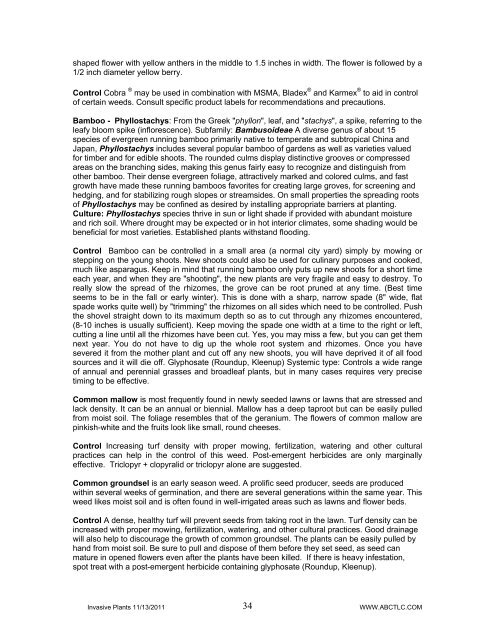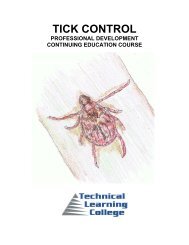INVASIVE PLANTS - Technical Learning College
INVASIVE PLANTS - Technical Learning College
INVASIVE PLANTS - Technical Learning College
You also want an ePaper? Increase the reach of your titles
YUMPU automatically turns print PDFs into web optimized ePapers that Google loves.
shaped flower with yellow anthers in the middle to 1.5 inches in width. The flower is followed by a<br />
1/2 inch diameter yellow berry.<br />
Control Cobra ® may be used in combination with MSMA, Bladex ® and Karmex ® to aid in control<br />
of certain weeds. Consult specific product labels for recommendations and precautions.<br />
Bamboo - Phyllostachys: From the Greek "phyllon", leaf, and "stachys", a spike, referring to the<br />
leafy bloom spike (inflorescence). Subfamily: Bambusoideae A diverse genus of about 15<br />
species of evergreen running bamboo primarily native to temperate and subtropical China and<br />
Japan, Phyllostachys includes several popular bamboo of gardens as well as varieties valued<br />
for timber and for edible shoots. The rounded culms display distinctive grooves or compressed<br />
areas on the branching sides, making this genus fairly easy to recognize and distinguish from<br />
other bamboo. Their dense evergreen foliage, attractively marked and colored culms, and fast<br />
growth have made these running bamboos favorites for creating large groves, for screening and<br />
hedging, and for stabilizing rough slopes or streamsides. On small properties the spreading roots<br />
of Phyllostachys may be confined as desired by installing appropriate barriers at planting.<br />
Culture: Phyllostachys species thrive in sun or light shade if provided with abundant moisture<br />
and rich soil. Where drought may be expected or in hot interior climates, some shading would be<br />
beneficial for most varieties. Established plants withstand flooding.<br />
Control Bamboo can be controlled in a small area (a normal city yard) simply by mowing or<br />
stepping on the young shoots. New shoots could also be used for culinary purposes and cooked,<br />
much like asparagus. Keep in mind that running bamboo only puts up new shoots for a short time<br />
each year, and when they are "shooting", the new plants are very fragile and easy to destroy. To<br />
really slow the spread of the rhizomes, the grove can be root pruned at any time. (Best time<br />
seems to be in the fall or early winter). This is done with a sharp, narrow spade (8" wide, flat<br />
spade works quite well) by "trimming" the rhizomes on all sides which need to be controlled. Push<br />
the shovel straight down to its maximum depth so as to cut through any rhizomes encountered,<br />
(8-10 inches is usually sufficient). Keep moving the spade one width at a time to the right or left,<br />
cutting a line until all the rhizomes have been cut. Yes, you may miss a few, but you can get them<br />
next year. You do not have to dig up the whole root system and rhizomes. Once you have<br />
severed it from the mother plant and cut off any new shoots, you will have deprived it of all food<br />
sources and it will die off. Glyphosate (Roundup, Kleenup) Systemic type: Controls a wide range<br />
of annual and perennial grasses and broadleaf plants, but in many cases requires very precise<br />
timing to be effective.<br />
Common mallow is most frequently found in newly seeded lawns or lawns that are stressed and<br />
lack density. It can be an annual or biennial. Mallow has a deep taproot but can be easily pulled<br />
from moist soil. The foliage resembles that of the geranium. The flowers of common mallow are<br />
pinkish-white and the fruits look like small, round cheeses.<br />
Control Increasing turf density with proper mowing, fertilization, watering and other cultural<br />
practices can help in the control of this weed. Post-emergent herbicides are only marginally<br />
effective. Triclopyr + clopyralid or triclopyr alone are suggested.<br />
Common groundsel is an early season weed. A prolific seed producer, seeds are produced<br />
within several weeks of germination, and there are several generations within the same year. This<br />
weed likes moist soil and is often found in well-irrigated areas such as lawns and flower beds.<br />
Control A dense, healthy turf will prevent seeds from taking root in the lawn. Turf density can be<br />
increased with proper mowing, fertilization, watering, and other cultural practices. Good drainage<br />
will also help to discourage the growth of common groundsel. The plants can be easily pulled by<br />
hand from moist soil. Be sure to pull and dispose of them before they set seed, as seed can<br />
mature in opened flowers even after the plants have been killed. If there is heavy infestation,<br />
spot treat with a post-emergent herbicide containing glyphosate (Roundup, Kleenup).<br />
Invasive Plants 11/13/2011 34<br />
WWW.ABCTLC.COM

















